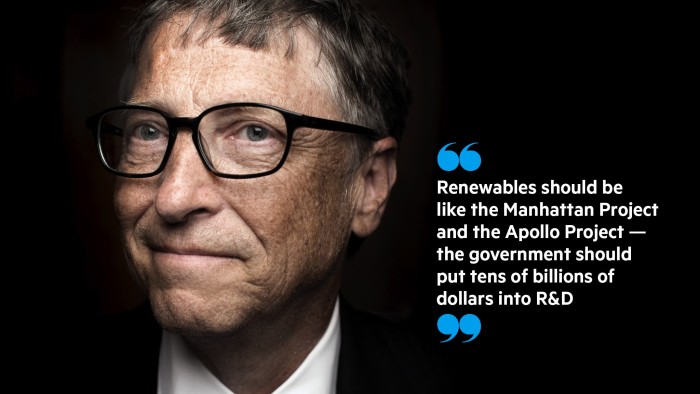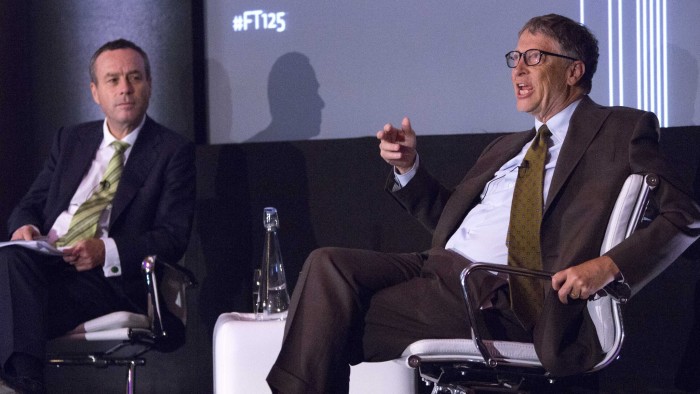Gates to double investment in renewable energy projects

Simply sign up to the Climate change myFT Digest -- delivered directly to your inbox.
Bill Gates is planning to double his personal investment in innovative green technologies to $2bn over the next five years in an attempt to “bend the curve” in combating climate change.
The billionaire philanthropist said he had already invested about $1bn in dozens of early stage companies — including battery storage, next-generation nuclear and free air carbon capture — hoping they would develop “breakthrough” technologies.
Mr Gates, who is listed by Forbes as the world’s richest person with a net worth of almost $80bn, said he had invested directly in about 15 companies and indirectly in another 30, via venture capital funds, Khosla Ventures and Kleiner Perkins. “Over the next five years, there’s a good chance that will double,” he said in an interview with the Financial Times.
The co-founder of Microsoft said it was “fantastic” that the UN, national governments, and environmental campaigners had raised awareness of climate change and were taking steps to counter it. However, he argued that current technologies could only reduce global CO2 emissions at a “beyond astronomical” economic cost. “The only way you can get to the very positive scenario is by great innovation,” he said. “Innovation really does bend the curve.”
Mr Gates urged governments to switch more resources from subsidising renewable energy into basic research. At present, government subsidies amounted to more than $100bn with only $6bn a year being invested in renewable energy R&D, he said. “Most of the people you talk to would say that we should double or triple the amount of renewables R&D.”
Rejecting calls from environmental campaign groups for shareholders to dump holdings in oil and gas companies, on the grounds this will have little impact, he instead urged “high-risk” investment in new technologies.
He said renewables were far from capable in their current form of capturing projected growth in energy use by 2030. He cited solar power as an example: “Solar is only during the day, solar only works best in places where it's warm. We don’t have perfect grids. We don’t have storage.
“There’s no battery technology that’s even close to allowing us to take all of our energy from renewables and be able to use battery storage in order to deal not only with the 24-hour cycle but also with long periods of time where it’s cloudy and you don’t have sun or you don’t have wind.
“Power is about reliability. We need to get something that works reliably.”
Another problem was that many energy suppliers did not have the right incentives to take risk and develop new technology, in the same way, say, as the pharmaceuticals industry. “They’re supposed to provide power at a certain bid cost. Would they get rewarded if they had a breakthrough in technology? Not much.”
Tens of billions of dollars should therefore be spent by governments on research and development in renewables over coming years, three times current levels, to identify reliable sources of “zero-carbon” power that can be exploited at scale, Mr Gates said.
“Because there’s so much uncertainty and there are so many different paths, it should be like the Manhattan Project and the Apollo Project in the sense that the government should put in a serious amount of R&D.”
Among the technology Mr Gates said was the most promising was “nuclear recycling”, where he has invested several hundred million dollars. His biggest single commitment was in a US-based company called TerraPower.
“Nuclear technology today is failing on cost, safety, proliferation, waste and fuel shortage, and so any technology that comes in has to have some answer to all of those things.” TerraPower’s reactors would be powered not by enriched uranium, used by traditional reactors, but by depleted uranium, the waste from today’s plants.
Depleted uranium is widely available as a raw material to be turned into energy. The plants using this spent fuel, so-called Travelling Wave Reactors, could be one solution to how to dispose of nuclear waste. A small amount of enriched uranium is needed to get them started, but they would run on waste, making and consuming their own supply.
In theory, they could run for decades without refuelling, making them a cheaper and safer alternative to existing reactors.
Another promising runner is “solar chemical” power. He pointed to work being done by professor Nate Lewis at the California Institute of Technology, who has been developing a form of artificial photosynthesis, based on the chemical process in leaves. This could lead to devices that harness sunlight to split water into hydrogen fuel.
Q&A
Robots, the role of government and Uber

Bill Gates, the founder of Microsoft and co-chair of the Bill and Melinda Gates Foundation, in an interview with Lionel Barber, the editor of the Financial Times, is asked about innovation, the role of government and the Uber economy.
Continue reading
“We need to get something that works reliably and solar chemical, because it makes liquid hydrocarbons, actually piggybacks one of the few energy storage things that works at scale, which is oil pipelines, gas tanks inside cars, which have over ten times the energy of any battery.”
High-altitude wind power was the third and most exotic-sounding potential technology. It would harness the kinetic energy of kites, “kytoons” — or kite balloons — and even flying turbines, tied to the ground by a system of cables and tethers.
This would tap into the energy of the jet stream that circles the planet at altitudes of 20,000 feet. “Capturing that energy is very difficult,” Mr Gates said. “It’s classic capitalism. There’s some wild-eyed companies, but it’s great. I wish governments would help those guys out because there’s a 10 per cent chance it’s the magic solution.”
Finally, there is one company he has funded, called Carbon Engineering, that takes the air we breathe and pulls the carbon dioxide out of that, an alternative to carbon capture and storage, where the gas is separated from power plant emissions and then stored underground.
As a parting shot Mr Gates compared the search for renewable technologies with the early days of the technology industry and predicted that some investors would make a lot of money by backing companies that would one day be successful.
“If I came and talked to you about software in the late 1970s, I would tell you: ‘Hey, somebody’s going to make a lot of money. Now there’s a tonne of software companies whose names will never be remembered . . . If you happened to pick Microsoft, Apple or Google, you would have made lots of money.”
. . .
Letters in response to this report:
Gates’s beneficence has spread even further / From JML Stone
Climate change caused by multiple market failures / From Bob Ward
Comments